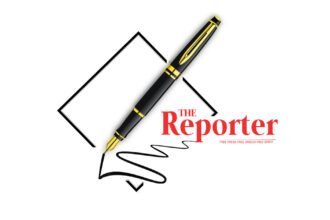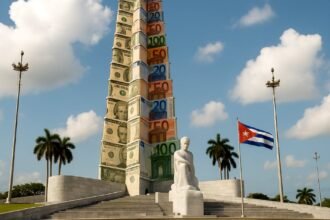The U.S. dollar has been the dominant currency in global trade and finance for more than seven decades. Over that time, little has ever truly threatened its position. Global economic systems operate with significant inertia. Major players, from governments to banks to multinational corporations, prefer tried and tested mechanisms for conducting trade and finance. Breathless headlines frequently declare that countries are seeking alternatives to the dollar, that a new consortium is attempting to create a rival currency, or that the latest political crisis in Washington will finally end the dollar’s reserve status. But through decades of changing economic growth around the world, periods of turmoil in global markets, and questions about the future of U.S. economic policy, the dollar’s dominance has remained secure.
Until now. On April 2, U.S. President Donald Trump announced steep new tariffs on almost every U.S. trading partner. His plans, which have sent U.S. and global stock markets plunging, are the latest example of a consistent theme in his approach to governance: the weaponization of U.S. economic power. Trump has slapped tariffs on goods from Canada and Mexico in response to a variety of purported ills and reinvigorated the maximum pressure campaign against Iran begun in his first term. Combined with Trump’s attacks on the rule of law, his clumsy, erratic attempts to weaponize Washington’s economic advantages pose the greatest threat so far to the dollar’s status as a reserve currency.
Should that threat be realized, the United States and the world will be worse off. Without the dollar to ease trade and financial flows, growth will be slower and people everywhere will be poorer. And U.S. isolation will not bring the manufacturing revival the Trump administration claims to be aiming for, as imported raw materials grow more expensive and capital markets dry up. The true result of a declining dollar will be the demise of the very economic power Trump is attempting to wield.
COMMON CURRENCY
Although the dollar overtook the British pound sterling in the mid-1920s as the currency of choice in global foreign exchange reserves, its stature as the world’s reserve currency was secured only at the Bretton Woods conference toward the end of World War II. That conference resulted in new institutions, the International Monetary Fund and the World Bank, and a new system in which currencies were pegged to the U.S. dollar, which was convertible to gold at a fixed price. Both the institutions and the dollar peg put currency stability at the center of the global economy. Since then, the dollar has retained its commanding position through multiple upheavals, surviving even the turmoil that followed U.S. President Richard Nixon’s 1971 decision to break the fixed dollar-to-gold exchange rate.
The dollar’s status depends on several features that any currency must possess if it hopes to make up the lion’s share of most countries’ foreign exchange reserves. At the most basic level, such a currency must be liquid—that is, easily bought and sold—and most people, banks, and businesses must agree to use it in their transactions. The dollar has long been dominant on both fronts. For more than three decades, between 85 and 90 percent of trades between currencies on foreign exchange markets have involved dollars. On the financial messaging system known as SWIFT, which international banks use to exchange tens of trillions of dollars each day, approximately 50 percent of transactions take place in dollars, up from around 35 percent a decade ago.
The world’s reserve currency doesn’t just need to be liquid and widely used; it also needs to function as the common unit of account for globally traded goods. Around the world, sales of commodities from oil to metals to crops are almost universally denominated in dollars. Some 54 percent of global trade invoices use dollar amounts, even though the United States accounts for only around ten percent of global trade.
The final requirement for a successful reserve currency is that people, businesses, and central banks consider it a reliable store of value. For that, the currency’s home country needs to have large and open financial markets with attractive investment opportunities predictably governed by the rule of law. Low and stable inflation helps, too, so the currency’s holders know the value of their assets will not evaporate overnight. The U.S. equity market is the largest in the world, with an overall value of $63 trillion at the end of 2024—amounting to nearly half the total value of the world’s equities, even after this year’s market rout. The U.S. economy is open to foreign investment: there are few restrictions on bringing capital into and out of the country. The Federal Reserve is widely viewed as independent and credible. And U.S. courts and regulators are trusted around the world to resolve business disputes, govern the economy predictably, and prevent significant corruption.
It also helps that the U.S. government bond market is the largest in the world, at around $28 trillion, over a quarter of the global market for government debt. U.S. government bonds (usually called Treasuries) are also the most liquid form of government debt, with around $900 billion in average daily transactions. That ease of buying and selling gives central banks comfort that Treasuries are a safe place to park cash. Taken together, these factors—liquidity, widespread use, and safety—make it hardly surprising that the dollar makes up the majority of international reserves and has done so for decades.
ONE OF A KIND
The dollar’s other great advantage as the world’s reserve currency is that it faces no credible challengers. The Chinese renminbi looms on the horizon, but China lacks open and liquid financial markets, one of the most important requirements for a reserve currency. The renminbi does not float freely on foreign currency exchanges. The Chinese government restrains the free flow of capital through measures such as controls on inbound and outbound investments and restrictions on international bank transfers. Foreigners face regulatory hurdles when investing in Chinese financial markets, including the local bond market, which also lacks the liquidity and depth of the world’s leading debt markets. China has attempted to promote its home-grown competitor to SWIFT, the Cross-Border Interbank Payment System (CIPS), especially since sanctions excluded some of Russia’s largest banks from SWIFT in 2022. But so far, CIPS has attracted just 0.2 percent of SWIFT’s transaction volume.
The dollar’s closest competitor is the euro, which meets many of the conditions for use as a global reserve currency. The eurozone has open and liquid capital markets, and the euro is the world’s second most widely traded currency and the second most commonly held reserve currency. Yet the eurozone does not include a fiscal union, and the bloc’s largest country, Germany, was, until earlier this year, reluctant to issue significant quantities of government debt. The lack of a unified eurozone fiscal policy led to the 2010–12 European debt crisis, which in turn caused a sharp drop in euro trading volumes on foreign exchange markets, euro-denominated SWIFT transactions, and the euro’s share in central bank reserves. The eurozone’s design flaws have been compounded by the fact that U.S. equities have returned nearly five times as much as their European peers over the past 15 years, leading asset allocators to concentrate investments in the United States. To make matters worse for the euro, the geopolitical threat to Europe posed by Russian imperialism has given central bankers yet another reason to steer clear of the currency.
Efforts to promote other upstart reserve currencies have so far gone nowhere. The BRICS group, a club of major non-Western economies, has floated a potential new currency that would compete with the dollar. In the near term, at least, this new currency, which will purportedly be backed by a basket of currencies from the participating countries, will pose no threat to dollar dominance. Not only is there no plan to create a common monetary or fiscal union within the BRICS, but the countries involved also differ widely in their domestic and international priorities. A currency created by a group far more fragmented than even the eurozone has no serious prospect of becoming the default choice for global business, especially since the BRICS has not yet explained how it might work.
Nor have shinier alternatives, such as bitcoin and gold, found much success. Cryptocurrencies lack many of the necessary characteristics to function as reserve currencies, including liquidity, price stability, and backing from either a government or another clear source of value. Gold has been used as currency for millennia and formed the basis for many monetary systems until relatively recently, but its weaknesses are now apparent. For one thing, governments cannot control the supply, so relying on gold constrains their ability to respond to economic crises.
THIS TIME IS DIFFERENT
Commanding as the dollar may be, Trump’s return to office has created a genuine threat to its status for the first time in generations. Given the lack of ready alternatives, the damage is unlikely to be immediately fatal, but the risk, and probable pace, of terminal decline has increased. At the least, Trump’s actions will erode the factors supporting the dollar’s dominance.
In his first weeks in office, Trump pursued policies that led to a strong dollar, but since then, the greenback has slumped against other currencies. At first, the dollar rallied as U.S. interest rates rose on the back of Trump’s inflationary policies, including tariffs, deportations, and proposed tax cuts. Those same policies, however, and the economic uncertainty they have created, are now weighing on the dollar, as markets expect them to hurt U.S. growth substantially, especially following the announcement of Trump’s aggressive and far-reaching global tariffs. Supply-chain disruptions driven by the trade war, labor shortages caused by deportations, and overall policy uncertainty are hurting business and consumer sentiment, leading to lower spending, lower growth, and lower interest rates. Largely as a result of Trump’s policies, European stocks outperformed the leading U.S. stock index by almost 20 percent over the first quarter of 2025, the biggest margin in more than three decades.
Look beyond the immediate horizon, and the risks of Trump’s policies are even greater. To begin with, Trump’s dramatic global tariffs, in addition to destabilizing the U.S. economy, will irrevocably damage the credibility of the United States as a trading partner. This will, in turn, undermine the need for and use of the dollar. U.S. allies will suffer the gravest harm, since many of them will face higher tariff rates than U.S. adversaries. Israel, Japan, and the EU, for example, are all subject to higher rates than Iran or Russia. Economists have shown that countries are more likely to hold reserves of currencies from their geopolitical partners. By alienating the United States’ closest allies, Trump is pushing away the countries that have been the most willing to rely on dollar-facilitated trade. Trump’s decision to turn against Ukraine in its conflict with Russia and his open questioning of NATO’s Article 5 mutual defense commitment are amplifying concerns about the United States’ willingness to keep its promises. As countries search for ways to limit their exposure to Trump’s whims, they are unlikely to rapidly reduce their dollar dependence, but in time, growing trade relations with China and other major economies could give businesses an incentive to replace the dollar in some transactions.
Sanctions will provide another reason to look elsewhere. The administration’s maximum pressure campaign against Iran and the forceful measures it has deployed against Venezuela indicate that the already widespread use of sanctions could ramp up even further in Trump’s second term. As more countries come under U.S. sanctions, they will be motivated to do what Russia did after 2018 and reduce their reliance on the dollar for cross-border trade and currency reserves. Even if these countries don’t shift away from the dollar entirely or replace it with a single dominant alternative, other payment systems like CIPS could start looking more attractive. China is the biggest trading partner for roughly two-thirds of the world’s countries; if CIPS becomes the only way to do business with Chinese companies, financial institutions in those places will have a powerful incentive to sign up. Rather than reshaping their trade patterns to fit U.S. preferences, countries will reshape their financial infrastructure to keep trade flowing.
Trump’s actions will erode the factors supporting the dollar’s dominance.
Perhaps the biggest danger to the dollar’s dominance comes from Trump’s threats to the rule of law, which will shake the foundation on which the dollar’s standing rests. The risk is not only that the administration may precipitate a constitutional crisis by defying the courts but also that a more corrupt and personalist form of government may become entrenched under a president inclined to cut deals with his friends and punish his enemies. A serious impediment to adoption of the Chinese renminbi is the rule of law, or rather the lack of it: companies would rather end up in an American courtroom than a Chinese one any day of the week. Should this U.S. advantage erode, the results could be catastrophic.
U.S. government debt, which the Congressional Budget Office has projected will rise from 100 percent of GDP to almost 150 percent by 2050, provides an additional risk. If Congress cuts taxes further without curbing spending (regardless of the budgetary tricks used in the process), the resulting debt will mean that a greater share of government revenue will go to interest payments rather than other spending priorities, hurting long-term economic growth and the appeal of U.S. assets. Some in the administration’s orbit have floated ideas, often under the title of a proposed Mar-a-Lago accord, that would make this problem significantly worse. These include compelling foreign investors to swap their U.S. government bond holdings for zero interest hundred-year bonds, which would hurt the credibility of the United States as a borrower and, by extension, the dollar’s standing. Forcing countries to take a loss on their U.S. bond holdings will scare away future buyers and, if the swap is involuntary, may even be classified as a default by credit rating agencies.
Finally, if the economy weakens, as many Wall Street banks are now projecting, Trump could find himself on a collision course with the Fed, as happened in his first term. The Fed has indicated that it will need more clarity on the inflationary effect of Trump’s tariffs before cutting interest rates further, while Trump is already demanding a looser monetary policy to stimulate a slowing economy—pressure that is likely only to increase. Should Trump’s pressure succeed, he will damage the Fed’s independence and credibility, which will, in turn, hurt the dollar’s global standing as countries begin to fear that politics, not economics, is steering U.S. monetary policy. The Fed anchors the entire dollar-based system, and once it has been politicized for one reason, it will be easier to politicize its operations for another. Central banks in such places as Canada, Japan, and Europe would, for example, rightly worry that, in a crisis, a politicized Fed might even cut off their prized ability to borrow dollars through swap lines in an effort to extract concessions.
Even if these threats do not dethrone the dollar entirely, any reduction in its standing would have serious consequences for the United States and the world. The dollar’s reserve status provides immense benefits to the United States, including lower interest rates on government debt and the power to impose hard-hitting sanctions. Other countries also find operating in the global economy easier with a readily transferrable, highly liquid, trusted currency used by most actors. The result of the dollar’s decline will be higher costs, more complicated trade, and reduced living standards—at least until another currency comes along to replace it.
The dollar has not always been the world’s reserve currency or the currency of choice for international trade. In the nineteenth century, it was the pound sterling that enjoyed that status, and British financiers would have felt secure in its reign. The United Kingdom had deep, liquid capital markets, and the British Empire was the world’s largest economy and the central player in global trade. Yet after two world wars and decades of political and economic decline, London watched as sterling’s global status ebbed away. There was nothing inevitable about the pound’s slide or the dollar’s emergence, just as there is nothing inevitable about the dollar’s potential demise today. Choices, not destiny, determine reserve currencies; if the dollar is finally dethroned, it will be a disaster of the Trump administration’s own making.
Loading…




















